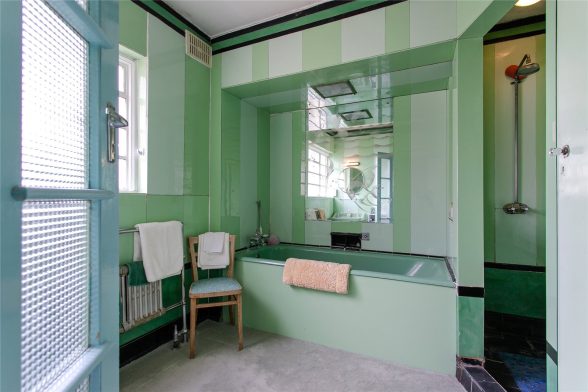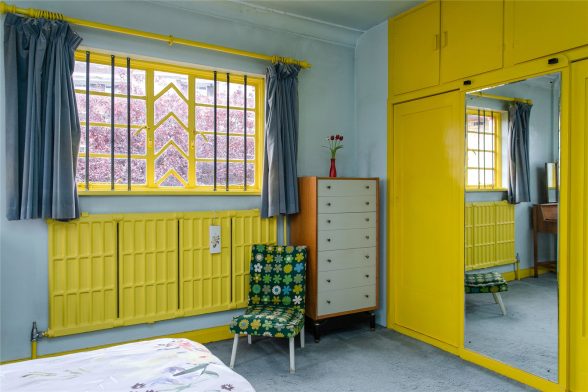This website uses cookies
This website uses cookies to enable it to function properly and to analyse how the website is used. Please click 'Close' to accept and continue using the website.



Image: Hamptons
A remarkably well preserved Art Deco house in South London has been saved from demolition, after an urgent intervention by C20 Society and the rare use of a Building Preservation Notice (BPN).
10 Dorchester Drive in Herne Hill was built in 1935-36 by Leslie H Kemp and Frederick E Tasker in collaboration with the builders Messrs Morrell. The house is based on the architects’ winning design for the Daily Mail Ideal Home Exhibition in 1934, which was exhibited in a setting titled ‘Village of Tomorrow’, and is one of only two known examples in the UK.
Having been in the same ownership for 60 years, the property was recently sold and, in a borough with some of the highest average house prices in the capital, its current unlisted status inevitably attracted the interest of property developers.
After lobbying by C20 Society, the Herne Hill Society and a raft independent experts, Lambeth Council yesterday agreed to issue a BPN, ahead of a listing assessment by Historic England.

Image: Hamptons
A BPN is issued by a local authority upon un-listed buildings of special architectural or historic interest. It’s a relatively underused tool that provides interim protection for a building prior to a listing assessment – something conservation bodies have long been calling for.
The notice clarifies that: ‘If works are carried out to the building without obtaining listed building consent, you will be liable to criminal prosecution’
This extends not just to outright demolition, but also alterations to any fittings and fixtures that might materially effect the heritage value of the property. After coming into force with immediate effect, the BPN then remains in place for six months, until the Secretary of State decides either to list the building, or that it doesn’t meet the criteria for listing.
For local authorities and those interested in pursuing a BPN for other buildings at risk, more information is provided in the Historic England website.

Courtesy of the Herne Hill Society
The Herne Hill house sits in a small cluster of significant 20th century properties, with Dorchester Court and 5 Dorchester Drive immediately opposite, both of which are already Grade II listed.
As the lavishly illustrated promotional material from 1934 describes, “On approaching the front of the house, the impression is of dignified simplicity”. It boasts of a 40 foot ballroom that comes from combining the lounge, hall and dining room, and remote-control wireless technology in every room.
Of the bathroom, a key original surviving feature, it describes “a coloured porcelain bath of the finest and most modern design, fitted with chromium plated fitments and a recessed soap dish” with “walls panelled in vitrolite and glass of varying colours” and “an outstanding feature – a separate shower enclosure”
Meanwhile a ‘sun balcony’ occupies the flat roof of the building and “will be welcomed by sun bathing enthusiasts”, and the huge bay window – a sweeping semi-circle of glass – stands out from the main building to “trap every ray of sunshine”.

Image: Hamptons
Professor Deborah Sugg Ryan (University of Portsmouth), a design historian, author and and the acknowledged expert on the Ideal Home Exhibition, said:
“This is one of the few surviving houses based on a show home exhibited at the Ideal Home Exhibition. It is the best example I have ever come across of this combination of International Style (which had previously been associated with avant garde patrons) and Moderne that British builders experimented with in the mid 1930s, when the market for speculative housing had reached saturation point.
This style was intended to reduce costs through its simplified form and construction and to appeal to marginal market groups. Though by the late 1930s, this particular Moderne style had more or less disappeared from the mass market.
Dorchester Drive has a remarkably intact original exterior and interior with superb examples of windows, mouldings, fixtures, fittings, built-in furniture and other decorative features. The vitrolite bathroom is particularly notable.”

Image: Hamptons
C20 Caseworker Coco Whittaker said:
“This is a really special built example of a 1930s ‘ideal home’ showhouse, designed to promote modern design and a modern way of living. One of only two known to exist in England, it is a rare survivor and really ought to be listed. We’re relieved that the local authority has responded quickly to our concerns and served a Building Preservation Notice and we wait now with bated breath to hear Historic England’s recommendation on our listing application”.
The case has echoes of the recent case of 57 Marine Drive in Rhos-on-Sea, a small seaside Art Deco house that was controversially approved for demolition in January. Despite a vigorous and widespread campaign to save the property, local councilors ultimately sided with developers, prompting debate in the Senned (Welsh Parliament) on the role of Cadw, the Welsh heritage body.

Courtesy of the Herne Hill Society

Become a C20 member today and help save our modern design heritage.